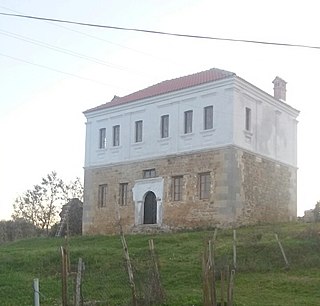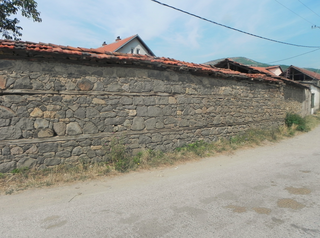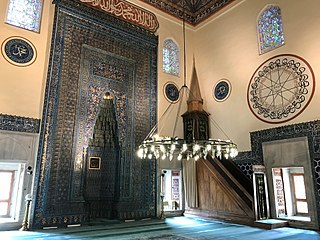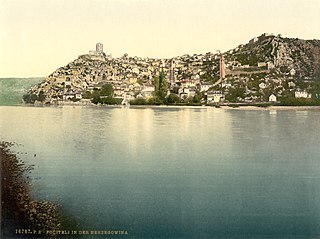| Mahmut Gjinolli House | |
|---|---|
| Native name Shtëpia e Mahmut pashë Gjinollit (Albanian) | |
 | |
| Location | Vushtrri, Kosovo |
| Built | 19th century |
The Mahmut Gjinolli House is a cultural heritage monument in Vushtrri Municipality, Kosovo. [1]
| Mahmut Gjinolli House | |
|---|---|
| Native name Shtëpia e Mahmut pashë Gjinollit (Albanian) | |
 | |
| Location | Vushtrri, Kosovo |
| Built | 19th century |
The Mahmut Gjinolli House is a cultural heritage monument in Vushtrri Municipality, Kosovo. [1]
The house of Mahmut Pasha Gjinolli, a member of prominent feudal lord Jashar Pasha Gjinolli’s family lies in western Vushtrri near the Terstena River. Historical records and oral tradition agree on its 19th-century origin. Later in the century, it became an Ottoman municipal office (Turkish : belediye). After World War II, it was put back into use for a similar purpose, going on to serve as an ambulance garage in the 1960s and a shelter for families displaced by floods in 1978. Including a basement and two above-ground floors, the building was built from natural stone reinforced by brick lines with some oak wood panels on the domed roof highlighted by a clock. The front façade is decorated in a Western-influenced style. The house's exterior is unchanged, and most interior changes amount to re-furnishing.
Facing eastward unlike most feudal buildings of the era, the house overlooks the city from what was at the time of construction its center to better observe the goings-on. Baroque and Ottoman elements coexist in this hybrid building. The domed clock testifies to a business-oriented mentality in the city at the time of construction. [2] [3]

Gjakova or Đakovica is the sixth largest city of Kosovo and seat of the Gjakova Municipality and the Gjakova District. According to the last census of 2024, the municipality of Gjakova has 78,824 inhabitants.

Prizren is the second most populous city and municipality of Kosovo and seat of the eponymous municipality and district. It is located on the banks of the Prizren River between the foothills of the Sharr Mountains in southern Kosovo. Prizren experiences a continental climate with some mediterranean influences.

Vushtrri is a city and municipality located in the Mitrovica District in Kosovo. According to the 2011 census, the town of Vushtrri has 26,964 inhabitants, while the municipality has 69,870 inhabitants. Vushtrri is surrounded by the city of Mitrovica to the north, Podujevë in the east, Obiliq in the south, Drenas in the south-west, and Skenderaj in the west. The municipality of Vushtrri has 67 villages.

The Sinan Pasha Mosque is an Ottoman-era mosque in the city of Prizren, Kosovo built by the Albanian pasha Sofi Sinan in 1615. The mosque overlooks the main street of Prizren and is a dominant feature in the town's skyline.

Tower houses developed and were built since the Middle Ages in the Balkans, particularly in Albania, Kosovo and Montenegro, but also in Bosnia and Herzegovina, Bulgaria, Greece, North Macedonia and Serbia, as well as in Oltenia, in Romania.
Monuments of Kosovo comprise all the monuments that are located in Kosovo.

Islamic monuments in Kosovo are commonly related with the Ottoman arrival in 1389, and respectively with their effective establishment in Kosovo in 1459. However, many historical evidences show that the first encounters of Islam with the Balkans happened well before the arrival of the Ottomans and their establishment in the Balkans. Because of its proximity to the centers of Islam, i.e., Middle East, the Byzantine Empire and parts of the Balkans, including the Albanian territories and Kosovo as well, were exposed to Islam as early as in the 8th century.

Mitrovica District is one of the seven districts of Kosovo. Its administrative center and the largest city is Mitrovica. The district borders on the District of Peja to the south-west, the District of Pristina to the south and east, and Serbia to the north and northwest.

The Kosovan city of Gjakova has been populated since the prehistoric era. During the medieval period, in 1485, Gjakova is mentioned as a village, concretely as a market place.

The Great Hammam of Pristina is an Ottoman-era monument in Pristina, Kosovo. It was built in the 15th century and was part of the Imperial Mosque. During the summer and spring, it was used as a meeting place. Considered one of the most important buildings of the cultural and historical heritage, the Great Hammam of Pristina was in poor condition through the years until its restoration was approved.
Mitrovica is one of the oldest settlements in Kosovo and a very important urban ensemble. There are many traces which have special interest and prove early civilization of the territory of Mitrovica, in particular from the Illyrian inhabitation in antiquity.

Historical monuments in Pristina are made up of 21 monuments out of a total of 426 protected monuments all over Kosovo. A large number of these monuments date back to the Byzantine and Ottoman periods. Since 1945, the Yugoslav authorities followed the idea of constructing a modern Pristina by relying in the urban development motto “destroy the old, build the new” and this resulted with major changes in the structure of the buildings, their function and their surrounding environment. However, numerous types of monuments have been preserved, including four mosques, a restored orthodox church, an Ottoman bath, a public fountain, a clock tower, several traditional houses as well as European-influenced architecture buildings such as the Museum of Kosovo. These symbolize the historical and cultural character of Pristina as it was developed throughout centuries in the spirit of conquering empires.
The architecture of Kosovo dates back to the Neolithic period and includes the Copper, Bronze and Iron Ages, Antiquity and the Medieval period. It has been influenced by the presence of different civilizations and religions as evidenced by the structures which have survived to this day. Local builders have combined building techniques of conquering empires with the materials at hand and the existing conditions to develop their own varieties of dwellings.

The architecture of Albania is a reflection of Albania's historical and cultural heritage. The country's architecture was influenced by its location within the Mediterranean Basin and progressed over the course of history as it was once inhabited by numerous civilisations including the Illyrians, Ancient Greeks, Romans, Byzantines, Venetians, Ottomans as well as modern Austro-Hungarians and Italians. In addition, missionaries, invaders, colonisers and traders brought cultural changes that had a large profound effect on building styles as well as techniques.

The Zeynullah Bey Tower House is a cultural heritage monument in Balince, Vushtrri, Kosovo.

The Hajrizi Mill or Gentleman's Mill is a cultural heritage monument in the village of Smrekonica, Vushtrri Municipality, Kosovo, aro.

The Gentleman's Will is a cultural heritage monument in Smrekonica, Vushtrri, Kosovo.

The Mahmut Pasha Hamam is a historic Ottoman hamam in Istanbul, Turkey. Founded by Mahmud Pasha, the grand vizier of Mehmet II, it was completed in 1466 and is one of the oldest surviving bathhouse structures in the city. It was part of the complex of the Mahmud Pasha Mosque, located northeast of the Grand Bazaar. After suffering damage over time, it was restored in the 20th century and now serves as a local shopping centre.

Early Ottoman architecture corresponds to the period of Ottoman architecture roughly up to the 15th century. This article covers the history of Ottoman architecture up to the end of Bayezid II's reign, prior to the advent of what is generally considered "classical" Ottoman architecture in the 16th century. Early Ottoman architecture was a continuation of earlier Seljuk and Beylik architecture while also incorporating local Byzantine influences. The new styles took shape in the capital cities of Bursa and Edirne as well as in other important early Ottoman cities such as Iznik. Three main types of structures predominated in this early period: single-domed mosques, "T-plan" buildings, and multi-domed buildings. Religious buildings were often part of larger charitable complexes (külliyes) that included other structures such as madrasas, hammams, tombs, and commercial establishments.

Walled town of Počitelj is a medieval fortified nucleus of Počitelj historic village, in the municipality of Čapljina, Bosnia and Herzegovina. Due to its significant architectural and urbanistic historical value, it is considered an open-air museum. The Walled town is nested in a natural karst amphitheater along the left bank of the Neretva river, on the main road Mostar-Metković. The walled nucleus is protected as a National Monument of Bosnia and Herzegovina. The architectural ensemble of Počitelj is also proposed as such for inscription into the UNESCO's list of World Heritage Sites. The bid for inscription is currently placed on the UNESCO Tentative list.